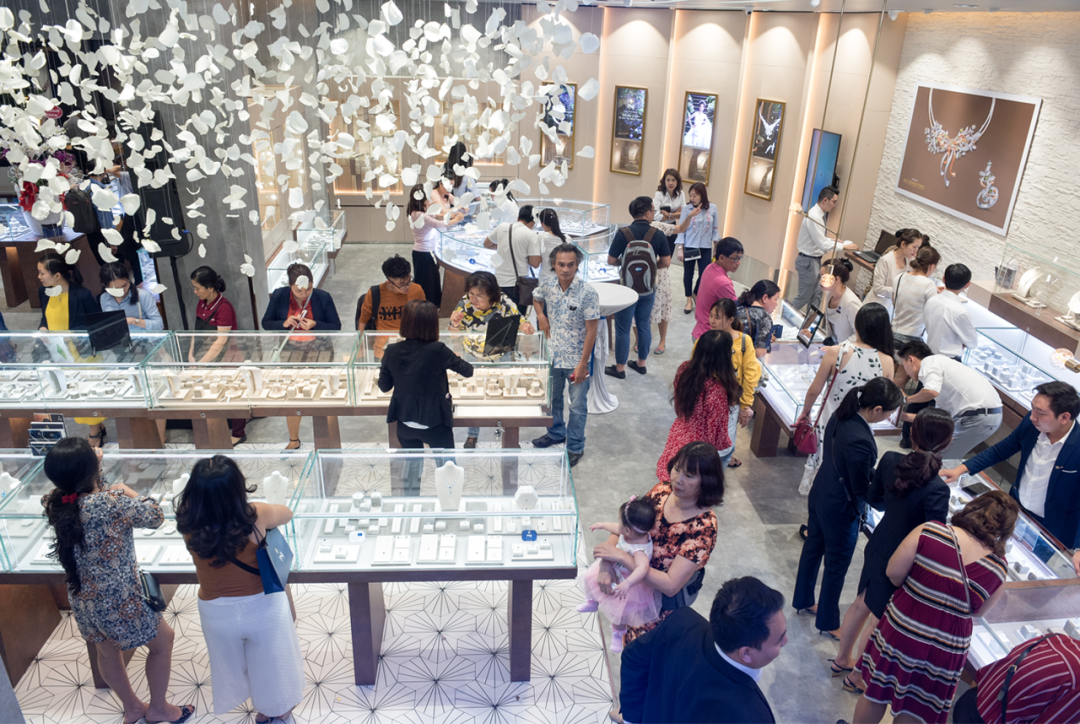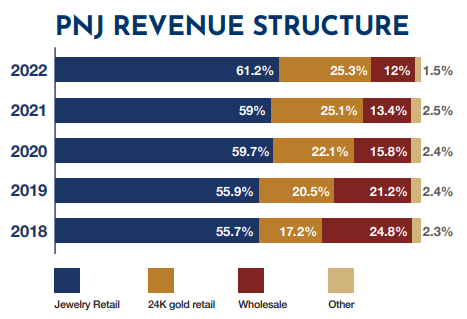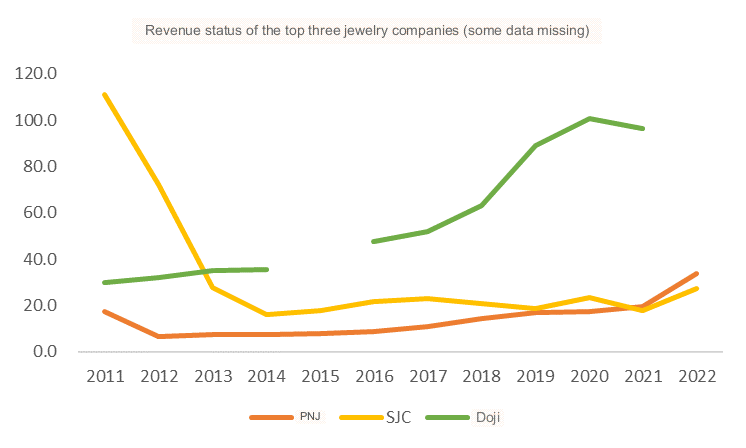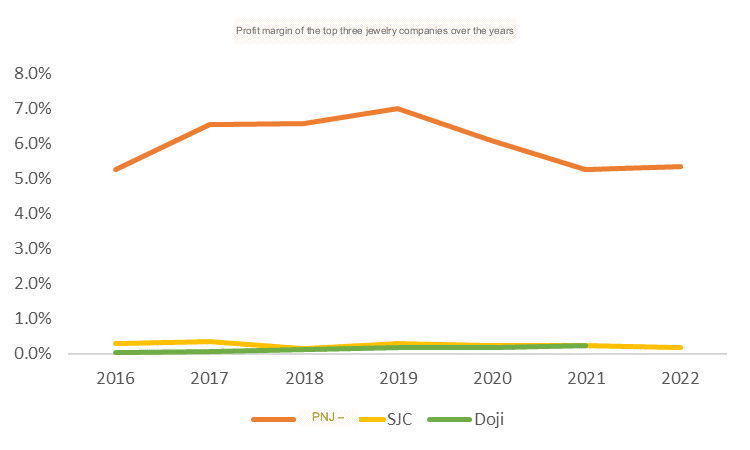Kirin Views is the second series of Kirin Capital towards the goal of “Know Vietnam, Long Vietnam”. This column provides Kirin’s observations and opinions on Vietnamese market through in-depth research driven by an expert team with decades of experience, assisting investors at home and abroad in better understanding the potential opportunities of Vietnam and join hands with “Know Vietnam, Long Vietnam”.
In the previous article about “Thế Giới Di Động” (Mobile World), we mentioned that the group attempted to enter the gold and silver jewelry market in 2022 with the brand AVAJi but had to discontinue it within six months due to the unfavorable economic conditions. However, there was a jewelry company called PNJ achieved an impressive growth rate of 73.3% in 2022, surpassing the overall consumer demand growth of 37% in the entire Vietnamese market.
Why did a jewelry company experience faster growth than everyday essential businesses? How did this company succeed and reflect the Vietnamese market’s and society’s characteristics? These are the questions that this article will answer.
01 PNJ: The Rise to Success
PNJ’s development can be divided into four stages.
1988 – 2000: From Ho Chi Minh City to Nationwide
PNJ’s Chairwoman, Ms. Cao Thi Ngoc Dung, graduated with a Bachelor’s degree in Business Economics from the Ho Chi Minh City University of Economics. After five years of working in planning departments of various companies, Ms. Dung was appointed as the manager of Phu Nhuan Jewelry (PNJ) in 1988. At that time, PNJ’s assets were equivalent to only 7.4 taels of gold. The jewelry industry was not well developed, and the market size was still limited. PNJ Jewelry Store was under the jurisdiction of the Phu Nhuan District People’s Committee.
In 1992, it was officially named Phu Nhuan Jewelry Company, and a development strategy was established to become a professional jewelry manufacturing enterprise. At this time, PNJ also established a 40% stake in Dong A Bank, expanding its business. Subsequently, PNJ established branches in Hanoi, Da Nang, and Can Tho in 1994, 1998, and 1999 respectively, initiating its strategy to expand nationwide.

2001-2011: Advancing Branding, Implementing Corporatization
In 2001, the PNJSilver brand was officially launched, offering young girls innovative and diverse silver jewelry that they loved. Three years later, on January 2, 2004, PNJ underwent the process of corporatization and transformed from a state-owned enterprise into Phu Nhuan Jewelry Joint Stock Company.
Subsequently, in 2005, the CAO Fine Jewellery brand was officially established and gradually became a leading luxury jewelry brand, with a mission to “embrace the beauty of elite women and modern aesthetics.” In March 2009, PNJ was officially listed on the HOSE (Ho Chi Minh City Stock Exchange), and its registered capital increased to 400 Billion VND.

2012-2018: Birth of a Local Supply Chain
In 2012, PNJ held multiple seminars and hired international consultants to establish standardized management systems in accordance with international standards. In October of the same year, PNJ Jewelry Factory was completed and recognized as one of the largest jewelry manufacturing factories in Asia.
In 2013, PNJSilver and PNJGold unveiled new brand identities, each with a unified image. Breakthroughs were made in product and brand development strategies, ranging from store decoration, uniforms, and services to luxurious and upscale sales spaces. The following year, PNJ had nearly 200 jewelry retail stores nationwide.
2019-Present: Focus on International Cooperation, Further Product Personalization
In 2019, PNJ officially entered a new development phase and partnered with the “big player” Walt Disney, seizing the opportunity to join the international market. They continuously launched new products featuring characters such as Cinderella and Mickey Mouse.
In 2020, PNJ was recognized as the Best Enterprise in the Asia-Pacific jewelry industry at the JNA Awards (referred to as the Oscars of the jewelry industry) and was valued at $93.1 million by Forbes Vietnam. In the same year, the new brand “STYLE By PNJ” was born, emphasizing personalization and stylish jewelry, expanding the customer base. In 2021, PNJ continued its journey to become a professional retailer by collaborating with Pandora and implementing a multi-brand distribution strategy.

So, how is PNJ’s current business situation?
02 Analysis of PNJ’s Business Situation
During the first two years of the pandemic, PNJ’s revenue growth was only 3% and 12% respectively. However, in 2022, it surged to an impressive 73.3%, resulting in a total revenue CAGR of 23.5% for the period of 2018-2022. This can be attributed to the following factors:
- After the easing of the pandemic, there was a significant increase in weddings among Vietnamese people, leading to a surge in demand for gold jewelry.
- PNJ consistently carried out promotional activities during occasions such as Mother’s Day, Women’s Day, and Valentine’s Day. They even invested in creating numerous videos to promote their brand. These videos tell real-life stories of women being proposed to, engaged, and married, highlighting the beauty and dedication of women while emphasizing PNJ’s presence throughout these important moments.
- Starting from the second half of 2021, PNJ established an official account on Zalo, providing consumers with a more convenient shopping channel in addition to their official website, Facebook fan page, and hotline.
- Product design: PNJ has over 1,000 jewelry craftsmen, including around 160 jewelry artists, accounting for approximately 70% of Vietnam’s total number of artists. This allows the company to continuously introduce new products based on various themes, ranging from the five elements, zodiac signs, and constellations to cartoon characters, beaches, and spring themes.

In addition to online sales channels, PNJ has hundreds of offline stores, including PNJGold (gold jewelry), PNJSilver (silver jewelry), CAO (high-end gold jewelry), and PNJNext (experience stores with interactive spaces). In 2022, there were a total of 364 stores, double the number from 2013, with 343 of them being PNJGold (including PNJNext).

PNJ’s business is primarily divided into three categories: jewelry retail, 24K gold retail, and wholesale business.
Among these, jewelry retail holds the largest share and continues to expand gradually. As of 2022, it accounted for 61.2% of the total revenue.
24K gold retail has grown from the smallest share to the second-largest business, representing 25.3% of the revenue in 2022.
The wholesale business, which presents some challenges, has shown slower growth and accounts for only 12% of the revenue.

In gold jewelry retail, traditional jewelry still accounts for 60%, while the remaining 40% consists of branded jewelry. Among this 40%, 56% comes from PNJ, making it the first-largest market share holder. The second and third positions are held by Doji (with its largest shareholder being the Chairman of TPBank) and SJC (a 100% state-owned enterprise under the Ho Chi Minh City People’s Committee), respectively.
Among these three companies, although PNJ has consistently had the lowest revenue for many years, it has the highest post-tax profit. The main reason for this is that its main business, jewelry retail, has a higher gross profit margin, resulting in an overall gross profit margin of nearly 20%. The other two companies primarily deal in gold (around 80%), with gross profit margins of only 0.5-1%.


03 Insights from PNJ’s Development
Product design is crucial. With the stability of the economy, Vietnamese consumers’ gold and silver purchasing habits have shifted from buying gold bars to purchasing gold jewelry. Therefore, in order to differentiate themselves from competitors, focusing on developing the jewelry retail business is the only way forward, and product design plays a particularly important role. PNJ’s skilled artisan team has capitalized on the change in Vietnamese preferences for jewelry – from caring about the gold content to valuing exquisite designs. As a result, they have created products that cater to different consumer groups with varying preferences.
A brand that tells stories is a good brand. PNJ celebrates the beauty and sacrifices of women by narrating different stages of a woman’s life through various product series. These stories resonate with different demographics, from young girls who adore Mickey and Minnie, to teenagers who dream of finding their Prince Charming like Cinderella, to independent women with a rebellious and distinctive personalities, and to mothers who always consider their children. As the status of women in Vietnamese society has improved, PNJ’s products have become the preferred choice for Vietnamese men when selecting special gifts for certain occasions.
The founder’s influence on company culture and growth is particularly significant. Ms. Cao has experienced two major setbacks in her life: one when she was diagnosed with cancer in 2000, and another when her husband was sentenced to two life imprisonments for illegal lending during his tenure as Deputy Chairman of DongA Bank in 2016. It is noteworthy that both of these events occurred during crucial stages of the company’s transformation, and Ms. Cao managed to overcome them and excel in her leadership.
During the pandemic, Ms. Cao also spearheaded the establishment of 30 zero-cost mini-supermarkets to assist the poor and unemployed workers. Additionally, despite the significant layoffs that occurred in many other companies in 2021, she raised the wages of over 5,000 of her employees. While Ms. Cao’s image has not been deliberately marketed, it aligns perfectly with the brand story of the company – that of a kind, resilient woman who possesses inner and outer beauty.
Kirin Capital is a research-driven equity investment company headquartered in Hanoi, Vietnam. Its core members have more than 20 years of financial experience in China and more than 10 years of financial and industrial investment experience in Vietnam. The investment covers TMT, large consumption, manufacturing, health care and financial services, and other fields, and spans all stages of equity investment such as seed investment, venture capital, private equity investment, listed company investment, and M&A investment.
Our vision is “Know Vietnam, Long Vietnam”. Through rich financial experience and local resources, we will be a guide for investors at home and abroad to invest in Vietnam and share Vietnam’s rapid growth development dividends.
If you have any needs related to the Vietnam market or would like to participate in our Kirin Views program and share your insights into the local market, please feel free to contact us HERE

